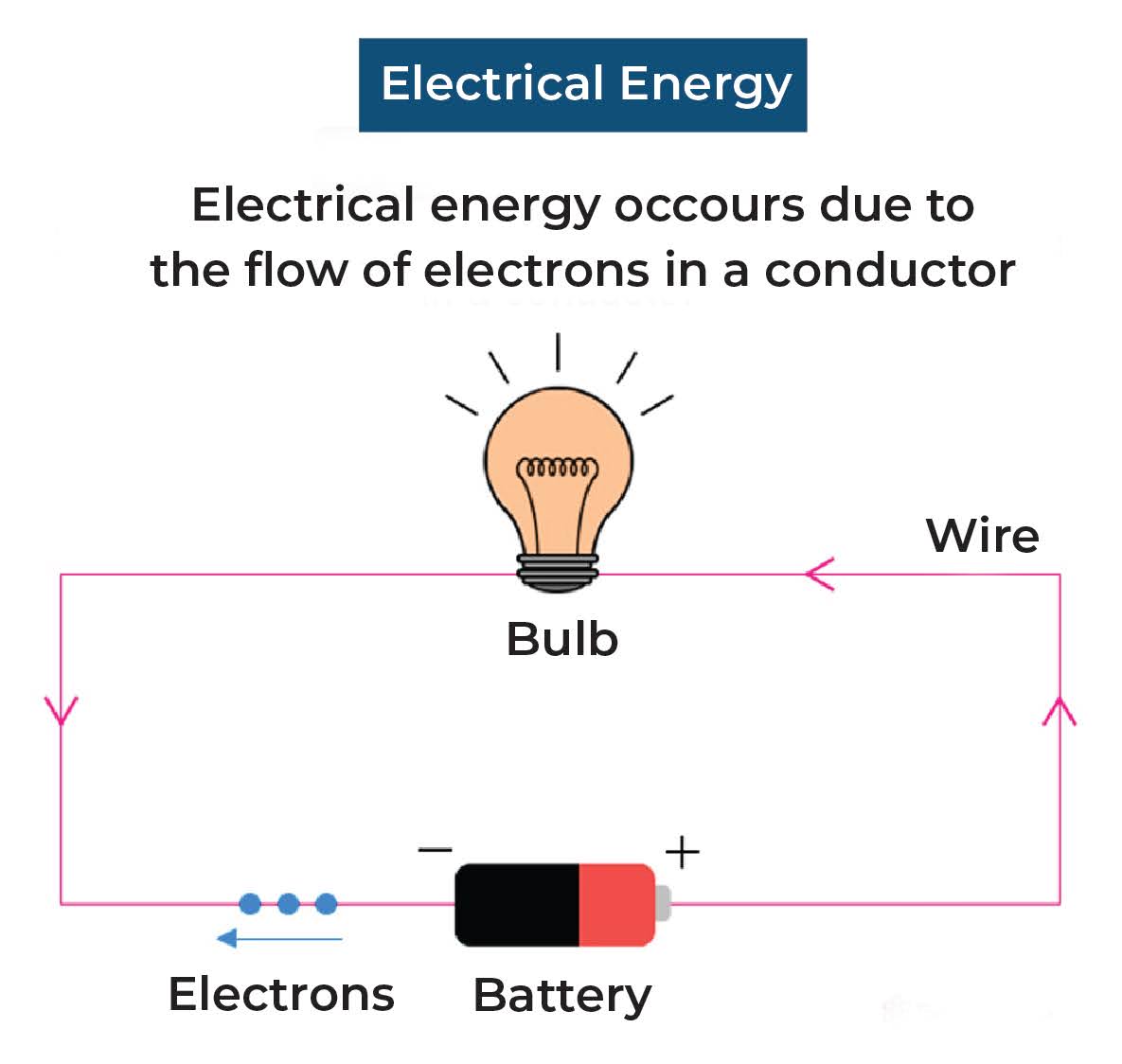What is Electrical Energy?
Grade 6 Science Worksheets
Electrical energy is a form of energy that arises from the movement of charged particles, typically electrons. It is a fundamental type of energy that powers a wide variety of devices and systems, from simple electrical circuits to complex industrial machinery and power grids.
Table of Contents:
- What is Electrical Energy?
- Formulae for Electrical Energy
- Conversion of Electrical Energy
- FAQs
What is Electrical Energy? - Grade 6 Science Worksheet PDF
This is a free printable / downloadable PDF worksheet with practice problems and answers. You can also work on it online.
|
|
Untimed |
|
Sign up with your email ID to access this free worksheet.
"We really love eTutorWorld!"
"We really love etutorworld!. Anand S and Pooja are excellent math teachers and are quick to respond with requests to tutor on any math topic!" - Kieran Y (via TrustSpot.io)
"My daughter gets distracted easily"
"My daughter gets distracted very easily and Ms. Medini and other teachers were patient with her and redirected her back to the courses.
With the help of Etutorworld, my daughter has been now selected in the Gifted and Talented Program for the school district"
- Nivea Sharma (via TrustSpot.io)
What is Electrical Energy?
Electrical energy can be generated from a variety of sources, including fossil fuels, nuclear power, renewable sources such as solar and wind power, and hydroelectric power from flowing water. The energy is often stored in batteries or capacitors for later use.

One of the key properties of electrical energy is that it can be easily converted into other forms of energy, such as mechanical energy or thermal energy, through the use of devices such as motors or heating elements.
Electrical energy is measured in units of joules or watt-hours, with one watt-hour being equivalent to one watt of power used for one hour. The cost of electrical energy is typically measured in units of kilowatt-hours, or 1000 watt-hours.
Overall, electrical energy is a vital component of modern life, powering everything from lights and appliances in homes to factories, hospitals, and transportation systems.
Formulae for Electrical Energy:
There are a few different formulae related to electrical energy, depending on what specific quantity you are interested in calculating. Here are a few of the most common formulae related to electrical energy:
Electrical energy (E) can be calculated as the product of power (P) and time (t): E = P x t. This formula expresses the fact that energy is the amount of power used over a certain period of time. The unit of electrical energy is the joule (J).
Power (P) can be calculated from voltage (V) and current (I) using the formula P = V x I. This formula expresses the fact that power is the rate at which electrical energy is being used. The unit of power is the watt (W), which is equivalent to one joule per second.
Electrical potential energy (U) can be calculated as the product of electrical charge (Q) and voltage (V): U = Q x V. This formula expresses the fact that energy is stored in an electrical field, and depends on both the amount of charge present and the strength of the field. The unit of electrical potential energy is the joule (J).
Electrical work (W) can be calculated as the product of electrical force (F) and distance (d): W = F x d. This formula expresses the fact that electrical work is done when a force moves a charged particle through a distance in an electrical field. The unit of electrical work is also the joule (J).
These are just a few of the many formulae related to electrical energy, and they can be used to calculate a wide range of quantities in electrical circuits and systems.
“There have been times when we booked them last minute, but the teachers have been extremely well-prepared and the help desk at etutorworld is very prompt.
Our kid is doing much better with a higher score.”
6th Grade Tutoring
eTutorWorld offers Personalized Online Tutoring for Math, Science, English, and Standardised Tests.
Our Tutoring Packs start at just under $22.49 per hour, and come with a moneyback guarantee.
Schedule a FREE Trial Session, and experience quality tutoring for yourself. (No credit card required.)
Conversion of Electrical Energy
There are many examples of the conversion of electrical energy into other forms of energy. Here are a few common examples:
Conversion of electrical energy to light: When an electric current is passed through a light bulb, the electrical energy is converted into light energy, which is then emitted from the bulb.
Conversion of electrical energy to heat: When an electric current is passed through a resistor, the electrical energy is converted into thermal energy, which can be used for heating purposes. Electric stoves and toasters are examples of devices that use this conversion process.
Conversion of electrical energy to mechanical energy: Electric motors are devices that convert electrical energy into mechanical energy. When an electric current is passed through a coil of wire in the motor, it generates a magnetic field that interacts with a permanent magnet to produce a rotating force.
Conversion of electrical energy to chemical energy: Batteries are devices that store electrical energy in the form of chemical energy. When a battery is charged, electrical energy is used to cause a chemical reaction that stores energy in the form of chemical bonds.
Conversion of electrical energy to sound energy: When an electric current is passed through a speaker, the electrical energy is converted into sound energy, which is then emitted from the speaker as sound waves.
These are just a few examples of the many ways in which electrical energy can be converted into other forms of energy. It is also important to note that electrical energy can be converted from other forms of energy.
For example, solar panels convert light energy from the sun into electrical energy, and wind turbines convert the kinetic energy of wind into electrical energy. In addition, electrical energy can be stored in batteries or capacitors for later use, allowing it to be used at a later time when it is needed.
Overall, the ability to convert and store electrical energy makes it a versatile and valuable form of energy in modern society.
Do You Stack Up Against the Best?
If you have 30 minutes, try our free diagnostics test and assess your skills.
Electrical Energy FAQS
What is electrical energy and how is it produced?
Electrical energy is a form of energy that arises from the movement of charged particles, typically electrons. It can be produced from a variety of sources, including fossil fuels, nuclear power, renewable sources such as solar and wind power, and hydroelectric power from flowing water.
How is electrical energy measured?
Electrical energy is measured in units of joules or watt-hours, with one watt-hour being equivalent to one watt of power used for one hour.
How is electrical energy converted into other forms of energy?
Electrical energy can be converted into a variety of other forms of energy, including light, heat, mechanical energy, chemical energy, and sound energy, through the use of different devices and processes.
How is electrical energy stored?
Electrical energy can be stored in batteries, capacitors, and other devices that are designed to store electrical charge.
What are some common uses of electrical energy?
Electrical energy is used in a wide variety of applications, including powering lights and appliances in homes, powering factories and industrial machinery, and providing energy for transportation systems such as trains and electric vehicles.
What are some environmental considerations associated with electrical energy production and use?
The production and use of electrical energy can have significant environmental impacts, particularly when fossil fuels are used as a source of energy. Renewable sources of energy, such as solar and wind power, are often seen as more sustainable alternatives to fossil fuels.
How is electrical energy distributed in power grids?
Electrical energy is typically distributed in power grids, which are networks of transmission lines, substations, and other components that are used to transport electrical energy from power plants to homes and businesses.

Kathleen Currence is one of the founders of eTutorWorld. Previously a middle school principal in Kansas City School District, she has an MA in Education from the University of Dayton, Ohio. She is a prolific writer, and likes to explain Science topics in student-friendly language. LinkedIn Profile
Affordable Tutoring Now Starts at Just $22.49
eTutorWorld offers affordable one-on-one live tutoring over the web for Grades K-12. We are also a leading provider of Test Prep help for Standardized Tests (SCAT, CogAT, MAP, SSAT, SAT, ACT, ISEE, and AP).
What makes eTutorWorld stand apart are: flexibility in lesson scheduling, quality of hand-picked tutors, assignment of tutors based on academic counseling and diagnostic tests of each student, and our 100% money-back guarantee.
Whether you have never tried personalized online tutoring before or are looking for better tutors and flexibility at an affordable price point, schedule a FREE TRIAL Session with us today.
*There is no purchase obligation or credit card requirement
Grade 6 Science Worksheets
- Inquiry process
- Nature of Science
- Scientific Inquiry
- Inquiry, Analysis and Problem Solving
- Ethical Practices
- Science and Society
- Biotic and Abiotic Factors
- Impact of Organisms
- Adaptation
- Spheres of Earth
- Natural Resources
- Environmental Issues
- Conservation of Earth
- Understanding Technology
- Abilities To Do Technological Design
- Structure of Earth
- Solar System
- Rocks and Fossils
- Earth Systems
- Plate Tectonics
- Evolution
- Magnetic Field of Earth
- Geologic Time
- Materials and Processes That Shape a Planet
- Astronomy
- Ecology
- Energy
- Kinetic and Potential Energy
- Energy Transfer
- Matter and its Structure
- States of Matter
- Physical and Chemical Changes
- Force and Motion
- Electricity and Magnetism
- Wave Interactions
- Sound
- Light
- Introduction to Life Science
- The Origin & History of Life On Earth
- Plant and Animal Cells
- Parts of a Cell
- The Cell Cycle
- How Living Organisms Get Energy
- Classification of Organisms
- How Plants Grow & Reproduce
- The Human Respiratory System
- The Human Cardiovascular System
- The Human Digestive System
- The Human Endocrine Systems
- The Human Nervous System
- The Human Muscular System
- The Human Skeletal System
IN THE NEWS

Our mission is to provide high quality online tutoring services, using state of the art Internet technology, to school students worldwide.
Online test prep and practice
SCAT
SSAT
ISEE
PSAT
SAT
ACT
AP Exam
Science Tutoring
Physics Tutoring
Chemistry Tutoring
Biology Tutoring
Math Tutoring
Pre-Algebra Tutoring
Algebra Tutoring
Pre Calculus Tutoring
Calculus Tutoring
Geometry Tutoring
Trigonometry Tutoring
Statistics Tutoring
Quick links
Free Worksheets
Fact sheet
Sales Partner Opportunities
Parents
Passive Fundraising
Virtual Fundraising
Our Expert Tutors
Safe and Secure Tutoring
Interactive Online Tutoring
After School Tutoring
Elementary School Tutoring
Middle School Tutoring
High School Tutoring
Home Work Help
Math Tutors New York City
Press
©2022 eTutorWorld Terms of use Privacy Policy Site by Little Red Bird
©2022 eTutorWorld
Terms of use
Privacy Policy
Site by Little Red Bird










